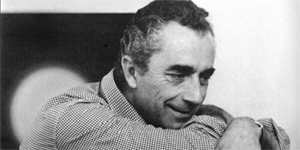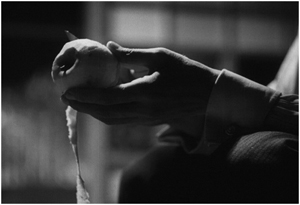MICHELANGELO ANTONIONI (1912-2007)
09.29.1912 - 07.30.2007
The same night the film world lost Ingmar Bergman, it also lost another one of the greatest living filmmakers: Michelangelo Antonioni, perhaps the greatest Italian filmmaker in the history of cinema, who died Monday night at the age of 94.
Truly a sad day… For Bergman is the filmmaker that open my eyes to world cinema, and Antonioni is the one whom inspires me to want to be a filmmaker. I listed Antonioni at #19 on my list of the top filmmakers. Here is what I wrote last year:
Very much like Federico Fellini, the earliest filmmaking development of Michelangelo Antonioni is in Italian Neorealism, where he began making documentary shorts about the working class. However, also like Fellini, Antonioni quickly abandoned the traditional sense of Neorealism (an era marked by Roberto Rossellini, Vittorio De Sica, and Luchino Visconti) in favor of his more abstract cinema. As a result, Antonioni is perhaps (to me anyway) the greatest expressionist and visual master in the history of Italian cinema. Antonioni’s films are less narrative conventions then they are experimentations of cinematic narrative. While Neorealism used social environments to define humanity and character, Antonioni uses environment and character in a mysterious and simplistic form of psychological expression. Antonioni’s concern is focused on the actual environment itself, just as much as it is with the characters of the environment. It is the environment that is a reflection of the characters and the emotional significance is an expression of the psychological state of mind of the characters. Antonioni’s particular fascination is modern architecture to convey the emotional state of his characters- which is generally distant, alienated, and lonely. It is this visually expressive examination of loneliness and alienation that Antonioni particularly masters. Especially in the way it is captured through environment. As such, landscapes and spaces become most prominent and memorable in all his work. This may be most evident in Antonioni’s richest period (1960s- notably his loose trilogy which begins with his most acclaimed film L’Avventura and concludes with his masterpiece L’Eclisse). Made in 1962 L’Eclisse is Antonioni at the peak of his artistic mastery, notably the incredible final montage sequence which captures his quintessential representation of space and landscape as a form of expression (as we see the films world through the backdrop, absent of it's characters). To me the film stands as one of the very great achievements of visual expressionism ever put on film and the final montage is a perfectly executed display in cinema at it's purest artistic form (images and sounds). Because of his reliance on environment as an expression of emotion, few filmmakers depend on their visual imagery more then Antonioni (at least since the invention of sound). As a result, many of his films and expression are done with silence- or as a “feeling”. That is where the narrative key of his films lie, as above all Antonioni is a filmmaker who searches for the feelings within human beings that live in a world where feelings are hidden inside. Images express feelings more effectively then dialogue, particularly the feelings that are most prominent in Antonioni’s films (loneliness, discomfort, sorrow). Antonioni finds the most expressive cinematic feelings through a lack of communication or in loneliness. Through his visual expression (as well as a gift with sound expression), Antonioni’s films reveal complex depths and psychological levels. As a purely artist filmmaker, Antonioni is without question one of the greatest of all-time!
Truly a sad day… For Bergman is the filmmaker that open my eyes to world cinema, and Antonioni is the one whom inspires me to want to be a filmmaker. I listed Antonioni at #19 on my list of the top filmmakers. Here is what I wrote last year:
Very much like Federico Fellini, the earliest filmmaking development of Michelangelo Antonioni is in Italian Neorealism, where he began making documentary shorts about the working class. However, also like Fellini, Antonioni quickly abandoned the traditional sense of Neorealism (an era marked by Roberto Rossellini, Vittorio De Sica, and Luchino Visconti) in favor of his more abstract cinema. As a result, Antonioni is perhaps (to me anyway) the greatest expressionist and visual master in the history of Italian cinema. Antonioni’s films are less narrative conventions then they are experimentations of cinematic narrative. While Neorealism used social environments to define humanity and character, Antonioni uses environment and character in a mysterious and simplistic form of psychological expression. Antonioni’s concern is focused on the actual environment itself, just as much as it is with the characters of the environment. It is the environment that is a reflection of the characters and the emotional significance is an expression of the psychological state of mind of the characters. Antonioni’s particular fascination is modern architecture to convey the emotional state of his characters- which is generally distant, alienated, and lonely. It is this visually expressive examination of loneliness and alienation that Antonioni particularly masters. Especially in the way it is captured through environment. As such, landscapes and spaces become most prominent and memorable in all his work. This may be most evident in Antonioni’s richest period (1960s- notably his loose trilogy which begins with his most acclaimed film L’Avventura and concludes with his masterpiece L’Eclisse). Made in 1962 L’Eclisse is Antonioni at the peak of his artistic mastery, notably the incredible final montage sequence which captures his quintessential representation of space and landscape as a form of expression (as we see the films world through the backdrop, absent of it's characters). To me the film stands as one of the very great achievements of visual expressionism ever put on film and the final montage is a perfectly executed display in cinema at it's purest artistic form (images and sounds). Because of his reliance on environment as an expression of emotion, few filmmakers depend on their visual imagery more then Antonioni (at least since the invention of sound). As a result, many of his films and expression are done with silence- or as a “feeling”. That is where the narrative key of his films lie, as above all Antonioni is a filmmaker who searches for the feelings within human beings that live in a world where feelings are hidden inside. Images express feelings more effectively then dialogue, particularly the feelings that are most prominent in Antonioni’s films (loneliness, discomfort, sorrow). Antonioni finds the most expressive cinematic feelings through a lack of communication or in loneliness. Through his visual expression (as well as a gift with sound expression), Antonioni’s films reveal complex depths and psychological levels. As a purely artist filmmaker, Antonioni is without question one of the greatest of all-time!




0 Comments:
Post a Comment
Subscribe to Post Comments [Atom]
<< Home